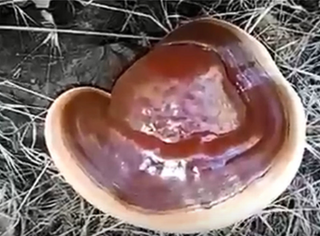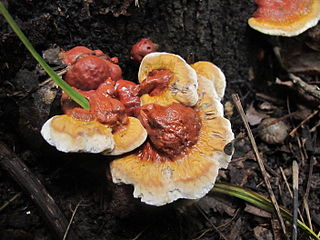
The Polyporales are an order of about 1800 species of fungi in the division Basidiomycota. The order includes some polypores as well as many corticioid fungi and a few agarics. Many species within the order are saprotrophic, most of them wood-rotters. Some genera, such as Ganoderma and Fomes, contain species that attack living tissues and then continue to degrade the wood of their dead hosts. Those of economic importance include several important pathogens of trees and a few species that cause damage by rotting structural timber. Some of the Polyporales are commercially cultivated and marketed for use as food items or in traditional Chinese medicine.

Polypores are a group of fungi that form large fruiting bodies with pores or tubes on the underside. They are a morphological group of basidiomycetes-like gilled mushrooms and hydnoid fungi, and not all polypores are closely related to each other. Polypores are also called bracket fungi or shelf fungi, and they characteristically produce woody, shelf- or bracket-shaped or occasionally circular fruiting bodies that are called conks.

Lingzhi, Ganoderma sichuanense, also known as reishi or Ganoderma lingzhi is a polypore fungus native to East Asia belonging to the genus Ganoderma.

Ganoderma lucidum is a red-colored species of Ganoderma with a limited distribution in Europe and parts of China, where it grows on decaying hardwood trees. Wild populations have been found in the United States in California and Utah, but were likely introduced anthropogenically and naturalized.

Ganoderma applanatum is a bracket fungus with a cosmopolitan distribution.

Ganoderma is a genus of polypore fungi in the family Ganodermataceae that includes about 80 species, many from tropical regions. They have a high genetic diversity and are used in traditional Asian medicines. Ganoderma can be differentiated from other polypores because they have a double-walled basidiospore. They may be called shelf mushrooms or bracket fungi.

Ganoderic acids are a class of closely related triterpenoids found in Ganoderma mushrooms. For thousands of years, the fruiting bodies of Ganoderma fungi have been used in traditional medicines in East Asia. Consequently, there have been efforts to identify the chemical constituents that may be responsible for the putative pharmacological effects. The two most well described ganoderic acids out of the many that have been identified and characterized are ganoderic acids A and B. Some ganoderic acids have been found to possess biological activities including hepatoprotection, anti-tumor effects, and 5-alpha reductase inhibition.

Ganoderma brownii is a species of polypore fungus in the Ganodermataceae family. It is a plant pathogen and occasional saprotroph similar in appearance to Ganoderma applanatum. This species is restricted geographically to the Pacific Northwest, primarily observed in California. In the San Francisco Bay Area, it is very common on Umbellularia californica.

Ganoderma orbiforme – most commonly known as G. boninense or just Ganoderma in oil palm pathology – is a species of polypore fungus that is widespread across southeast Asia. It is a plant pathogen that causes basal stem rot, a disease of the African oil palm. The fungus was first described scientifically in 1838 by Elias Magnus Fries from collections made in Guinea. Leif Ryvarden transferred it to the genus Ganoderma in 2000. In addition to its type locality, the fungus has also been collected from the Bonin Islands in the Pacific, and from Venezuela and Puerto Rico.

Ganoderma tornatum is a fungal plant pathogen in the genus Ganoderma. It is a species of basidiomycete fungi in the family Polyporaceae.
Shennong Bencaojing is a Chinese book on agriculture and medicinal plants, traditionally attributed to Shennong. Researchers believe the text is a compilation of oral traditions, written between about 206 BC and 220 AD. The original text no longer exists, but is said to have been composed of three volumes containing 365 entries on medicaments and their description.
Humphreya is a genus of four species of polypore fungi in the family Ganodermataceae. The genus was circumscribed by Belgian mycologist René Léopold Steyaert in 1972. He proposed Humphreya as a genus segregate from Ganoderma, typified by Ganoderma lloydi Pat. & Har., and included Ganoderma coffeatum and the newly described Humphreya endertii. H. eminii was transferred to the genus by Leif Ryvarden in 1980.
Bernardo T. Chua is from the Philippines and has worked for years in multi-level marketing. He worked as an executive with Gano Excel first in the Philippines. After three years he helped expand Gano Excel to Hong Kong and Canada and then to the United States. Chua moved to California and became president of Gano Excel U.S.A. Gano Excel marketed products with ganoderma in them. These products included capsules, instant coffee and other food products.

Elaeis guineensis is a species of palm commonly just called oil palm but also sometimes African oil palm or macaw-fat. It is the principal source of palm oil. It is native to west and southwest Africa, specifically the area between Angola and the Gambia; the species name, guineensis, refers to the name for the area, Guinea, and not the modern country now bearing that name. The species is also now naturalised in Madagascar, Sri Lanka, Malaysia, Indonesia, Central America, Cambodia, the West Indies, and several islands in the Indian and Pacific Oceans. The closely related American oil palm Elaeis oleifera and a more distantly related palm, Attalea maripa, are also used to produce palm oil.

Ganoderols are triterpenes isolated from Ganoderma lucidum.

Ganodermadiol is a sterol isolated from Ganoderma.
Medicinal fungi are fungi that contain metabolites or can be induced to produce metabolites through biotechnology to develop prescription drugs. Compounds successfully developed into drugs or under research include antibiotics, anti-cancer drugs, cholesterol and ergosterol synthesis inhibitors, psychotropic drugs, immunosuppressants and fungicides.

Ganoderma sessile is a species of polypore fungus in the Ganodermataceae family. This wood decay fungus is found commonly in Eastern North America, and is associated with declining or dead hardwoods. There is taxonomic uncertainty with this fungus since its circumscription in 1902.

Ganoderma microsporum is a species of Ganoderma mushroom native to Taiwan that grows on willow trees. The specific epithet microsporum refers to the small size of its spores, measuring 6–8.5 by 4.5–5 μm, which is smaller than the spores of all other known types of Ganoderma.















